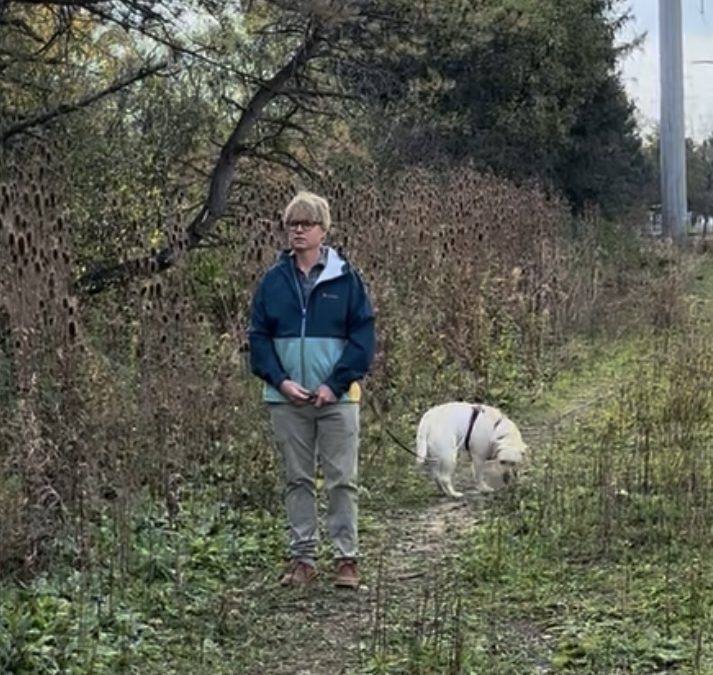The Most Salient Cue for Recall is Visual: Body Language
For your dog to have recall, to come back to you, you need to have a good relationship with your dog. A good relationship has nothing to do with treats; it has to do with being kind, gentle, patient, trustworthy, and respectful.
Instead of training dogs to be at our heel, we train people to be with their dog when their dog needs them. If your dog needs you: instead of calling your dog to come back to you, consider going to be with your dog.
No Treats and Be Quiet
Don’t get your dog riled up. Keep from baby talk. Speak in whispers, if at all. If you say your dog’s name, or anything, in an emotionally charged or commanding way it causes the opposite of recall.
Go Slow
Slow is a Calming Signal http://en.turid-rugaas.no/calming-signals—the-art-of-survival.html
A slow recall is typically better than a fast recall. Let your dog sniff. There’s no hurry. If you need a fast recall for some reason: take a few quick steps away. But beware: the faster your dog goes the more likely your dog is to cause other dogs to be reactive towards your dog and the more likely your dog is to be reactive towards other dogs, people, etc.
Use Your Body Language
When you’d like your dog to comel, vision is typically the most salient of a dog’s senses. Be where your dog can see you. When you are anywhere in your dog’s field of vision, including the peripheral, turn your body and wait for your dog to come. Be quiet and wait. Let your dog have time to finish what your dog is doing and to process your body language. It might feel like a long time. Be patient, be quiet, and wait. Being quiet and waiting is the hardest part for many people.
As long as your dog has any vision: recall is a visual, not audible, cue. The movement of your body, turning, catches your dog’s eye. Your body turning doesn’t need to be a big turn. A little movement is all your dog will need to see that you moved. Your dog might need a little time to finish what your dog is doing, thinking about, observing, learning.
Sometimes a dog is uncomfortable with something that’s in the direction you’re facing. If you think this might be the case, try facing in another direction.
Turn Your Body and Face in the Direction You’d Like to Go
Your nose, shoulders, hips, knees, and toes should all be pointing in the same direction. That is clear communication. Give your dog time to process. Be quiet and wait. When your dog comes to you, don’t make a big deal. If you’re going to walk, go ahead and walk. Let your dog sniff. Let your dog enjoy their walk. Being together and enjoying where you are is inherently rewarding.
People often face their dog. Facing your dog tells your dog to go away. If you face your dog and say the word “come,” that’s a mixed message.
Your dog’s vision is more salient than their hearing. What they see is go away; they don’t hear the word “come” as much as they see your body saying “go away.” Turning your body and facing away lets your dog know that you’d like to go in the direction you’re facing.
When Your Dog Can’t See You
Go to be where your dog can see you. If for some reason you can’t go to where your dog can see you: make the Attention Sound https://www.nordicdogtrainer.com/2022/12/09/what-is-the-attention-sound/
Be patient, and wait.
Refrain from Using Separation Stress
At most, you might take one or two steps away. Just one, maybe two steps. That’s all. Don’t go too far away from your dog to make your dog come to you. Don’t make your dog afraid that you might leave them behind. That’s unkind. Instead, reassure your dog by being with them, not too far away. If your dog is comfortable with you, your dog will come to be with you. Give your dog some time. Sometimes they just need to take a break. Your dog might sit or lie down. Give them time.
Recall goes both ways. When my dog turns her body to go in a direction, I often follow, so she gets to go where she likes.
Recall is a key ingredient for Loose Leash Walking https://nordicdogtrainer.simplero.com/page/200463
Before your dog pulls: stop, turn, and wait. Wait for your dog to come. They will, eventually, if you let them. Sprinkle recall on occasion. While you’re out on a walk: stop, turn and wait. Recall takes patience, it takes a little time. Let your dog have that. They’ll love you for it.
If your dog is on leash, use a good harness and not less than a 10-foot leash. Here’s where you can order a good harness: https://thecollarlessdog.com/ and here is where you can order a 10-foot leash: https://www.coastalpet.com/products/detail/?id=TRL01. For ideas about how to have a stress free walk, here’s a link to the Nordic Education Centre for Ethical Dog Training, where you can get a free guide: https://nordicdogtrainer.simplero.com/page/653130
About the Author:
Lennox Armstrong is an International Dog Trainer School (IDTS) certified Dog Trainer, Calming Signals and Dog Behavior Specialist through the Nordic Education Centre for Ethical Dog Training. His primary professional focus is educating himself and others about how to take care of canines.

